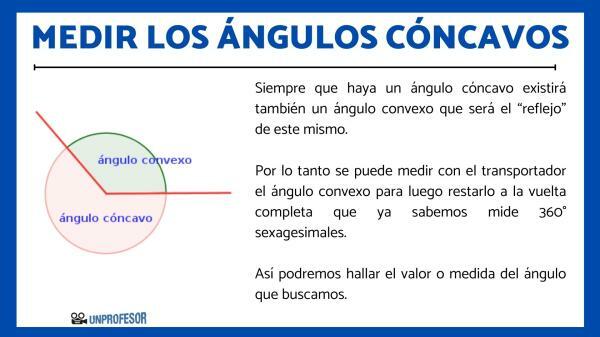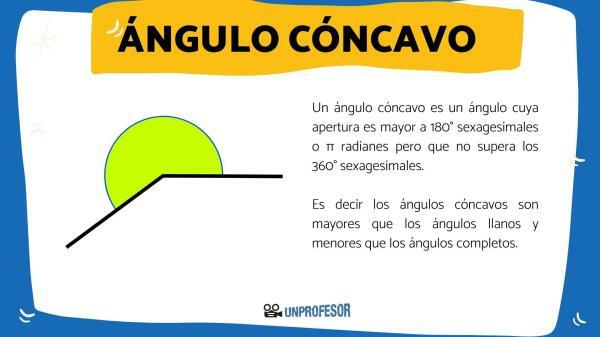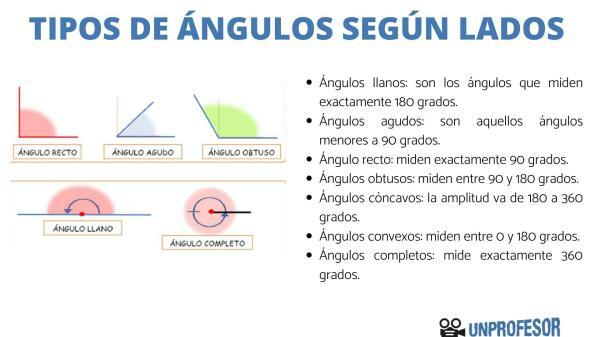How CONCAVE angles are measured

There are different types of angles and among them we can classify concave angles as those whose amplitude exceeds 180° sexagesimal but less than 360° sexagesimal. In a new lesson from a Teacher we will see How are concave angles measured?. We will begin by reviewing the concept of angle, along with its types and classification. Then we will see in detail what the concave angles are. Will study How are concave angles measured?, to finish with some exercises on the topic.
The concave angles are those in which Its amplitude exceeds 180° sexagesimal but that are less than 360° sexagesimal, as we said previously.
When we are analyzing a concave angle we must note that at the same time we can find as its “reflection” an angle convex, that is, the missing portion of a concave angle to complete the complete turn is an angle convex.
Characteristics of concave angles
- They are angles whose amplitude is greater than 180° and less than 360° sexagesimal.
- They are included between the two segments that form the angle.
- They cannot be null, acute, straight, obtuse, flat or complete.
- They are greater than straight angles, but less than complete angles.
- They are always facing or reflecting with a convex angle.

As the protractor or semicircle can only measure angles of up to 180° sexagesimal due to its shape, a way must be found to be able to measure concave angles.
We know that Whenever there is a concave angle, there will also be a convex angle. which will be the “reflection” of it, therefore the convex angle can then be measured with the protractor and then subtract it from the full turn which we already know measures 360° sexagesimals, and thus find the value or measure of the angle we are looking for.
Example
If we want to measure a concave angle with the protractor, we know that this will not be possible. So we measure its convex reflection with this instrument and we found an amplitude of 20° sexagesimals. How long will the concave angle measure then?
Since the complete turn has an amplitude of 360° and the convex angle that complements it measures 20° sexagesimals, then we perform the subtraction and find the angle:
360° - 20° = 340°
Therefore the concave angle we were looking for measures 340° sexagesimal.

The angles They are a portion belonging to the plane that It is formed from two rays that have a common vertex. That is, when two segments join at a vertex, the amplitude that exists between them is what we call the angle.
Elements of an angle
- Sides: are the segments or semi-straight lines that form it
- Vertex: is the joining point of the sides
- Amplitude: the opening achieved between the sides joined by the vertex is what is called amplitude.
To measure angles, the sexagesimal measurement system is used, so degrees, minutes and seconds are used to note them.
To make these measurements, an instrument called a semicircle or protractor is used.
Types of angles
Angles can be classified in the following way:
- Null angle: it is an angle whose amplitude is 0° sexagesimal, meaning that the two segments that form it are coincident.
- Acute angle: it is an angle whose amplitude is greater than 0° and less than 90° sexagesimal.
- Right angle: it is an angle whose amplitude measures exactly 90° sexagesimal.
- Obtuse angle: it is an angle whose amplitude is greater than 90° and less than 180° sexagesimal.
- Plain angle: it is an angle whose amplitude measures exactly 180 sexagesimal degrees.
- Complete angle: it is an angle whose amplitude measures exactly 360° sexagesimal, meaning that the segments that form it are coincident but have rotated one complete revolution.
- Apart from this classification we can find that angles can also be divided into concave and convex.
- Convex angles are those whose amplitude measures between 0° and 180° sexagesimal, while concave angles have an amplitude between 180° and 360° sexagesimal.

Determine if the following statements are true or false.
- Angle 183° is concave
- Angle 179° is concave
- The 35° angle is the convex reflection of the 250° sexagesimal angle.
- The 46° angle is convex
Solutions
- TRUE. The angle 183° is greater than 180° and less than 360° sexagesimal, therefore it is concave.
- Fake. The angle 179° is less than 180° sexagesimal, therefore it is convex.
- Fake. The reflex concave angle of 35° is 325° sexagesimal.
- TRUE. The angle 46° is convex because it measures more than 0° and less than 180° sexagesimal.
If you liked this lesson, share it with your classmates. And remember that you can continue browsing the page. On the unProfesor website there is very interesting content that may be useful to you.

